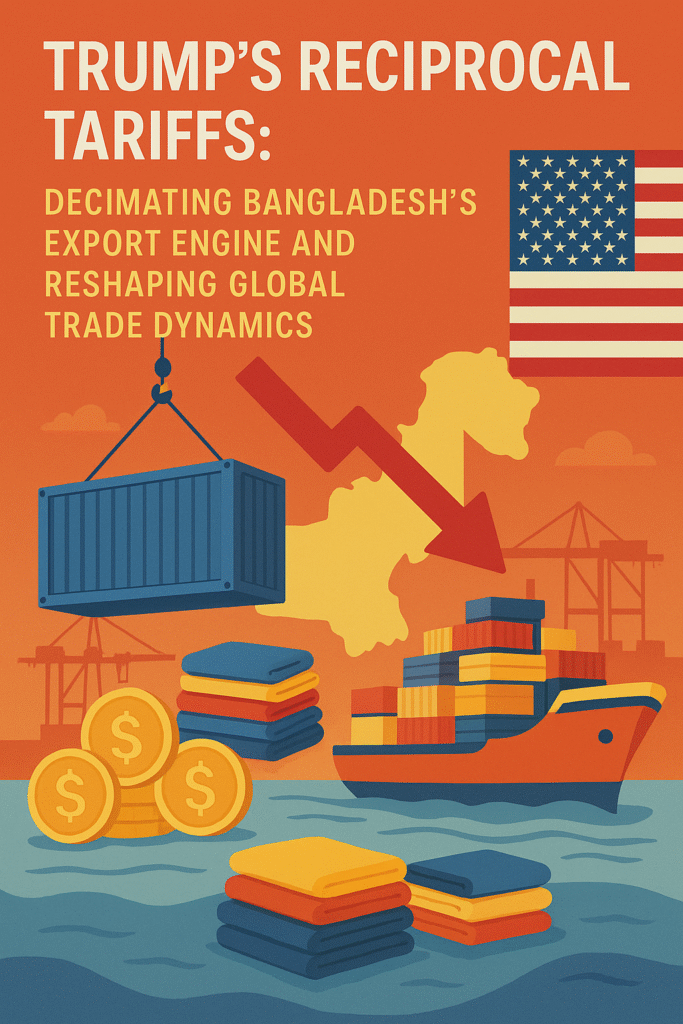
The United States’ imposition of a 37% tariff on Bangladeshi exports under former President Donald Trump’s “Reciprocal Tariffs” policy marks a seismic shift in trade relations, with far-reaching consequences for Bangladesh’s economy and the fragile architecture of global commerce. While framed as a corrective measure against “unfair” trade practices, the policy risks crippling Bangladesh’s garment sector, destabilizing its macroeconomic stability, and accelerating a dangerous cycle of protectionism.
The White House justifies the 37% tariff by claiming Bangladesh maintains a 74% effective tariff on U.S. goods—a figure that demands scrutiny. While Bangladesh does impose higher tariffs in sectors like agriculture and automobiles to protect domestic industries, its average applied tariff stands at 14.1%, according to World Bank data. The U.S. calculation likely inflates figures by including non-tariff barriers or disputed regulatory measures, reflecting a politicized interpretation of trade imbalances. This approach mirrors Trump’s earlier trade wars, where tariffs were weaponized as negotiating tools rather than economic remedies. For Bangladesh, a nation where ready-made garments (RMG) constitute 84% of exports and the U.S. accounts for 18% of its global shipments, the tariff hike is existential.
The effects are particularly noticeable in Bangladesh’s RMG industry, which employs more than 4 million people and accounts for 11% of the country’s GDP. A 37% tariff could erase the country’s cost advantage over competitors like Vietnam (facing a 46% U.S. tariff) and India (26%), pushing global buyers toward less-penalized nations. With profit margins typically ranging between 5–10%, manufacturers cannot absorb the tariff without slashing wages or jobs, risking social unrest. The government, already grappling with dwindling foreign reserves (down to 26billioninJune2024from26billioninJune2024from48 billion in 2021) and a looming IMF loan program, faces reduced export earnings that could exacerbate pressure on the taka and cripple import capacity for essentials like fuel and machinery.
In addition to causing short-term financial hardship, the policy breaks the mutually beneficial nature of global supply chains. American retailers like Walmart and Gap, which rely heavily on Bangladeshi apparel, will confront higher costs, potentially passing these onto consumers already battling inflation. Meanwhile, Bangladesh’s attempts to diversify exports—such as leather goods or IT services—remain nascent, leaving it overly reliant on an embattled sector. The tariff could also derail Dhaka’s sustainability initiatives, as factories investing in green technologies face diminished returns amid shrinking margins.
Trump’s unilateral tariffs are undermining the WTO’s non-discrimination and proportionality principles globally. While Bangladesh lacks the economic leverage for direct retaliation, collective action with other targeted nations like India, Pakistan, and Sri Lanka could challenge the measures through WTO disputes or regional trade pacts. Alternatively, affected countries may deepen ties with China or the EU, reshaping alliances in ways that marginalize U.S. influence. For the U.S., the policy risks alienating allies and reviving the cycle of reciprocal tariffs seen during the 2018–2020 trade wars, which cost American households $1.7 trillion in higher prices and economic losses.
Bangladesh’s predicament underscores chronic vulnerabilities: overreliance on a single sector, inadequate export diversification, and geopolitical marginalization. While the government has sought to negotiate tariff exemptions, its limited diplomatic clout compared to Vietnam or India highlights the need for strategic partnerships. The crisis may also accelerate automation in the RMG sector to cut costs, potentially displacing workers without viable alternatives and exacerbating unemployment in a country already struggling to create jobs for its youth.
To navigate this turmoil, Bangladesh must urgently engage in bilateral talks, emphasizing its role in providing affordable apparel to U.S. consumers and compliance with labor reforms. Diversifying exports and markets—particularly in Asia and Africa—is critical. Simultaneously, investing in high-value sectors like pharmaceuticals and leveraging trade agreements with Japan or South Korea could reduce dependency on Western markets. Domestically, enhancing ease of business and reducing bureaucratic delays will be vital to retain investor confidence amid the turbulence.
The U.S. tariff gambit, while politically resonant, is economically myopic. For Bangladesh, the policy is a wake-up call to address structural weaknesses; for the world, it signals a perilous retreat from cooperative trade norms into zero-sum nationalism. The true cost will be measured not just in lost exports, but in the erosion of a rules-based global order that once sought to balance competing interests through dialogue—not punitive unilateralism.
This article was published on Publicfinance.pk
Source: www.thedailystar.net
